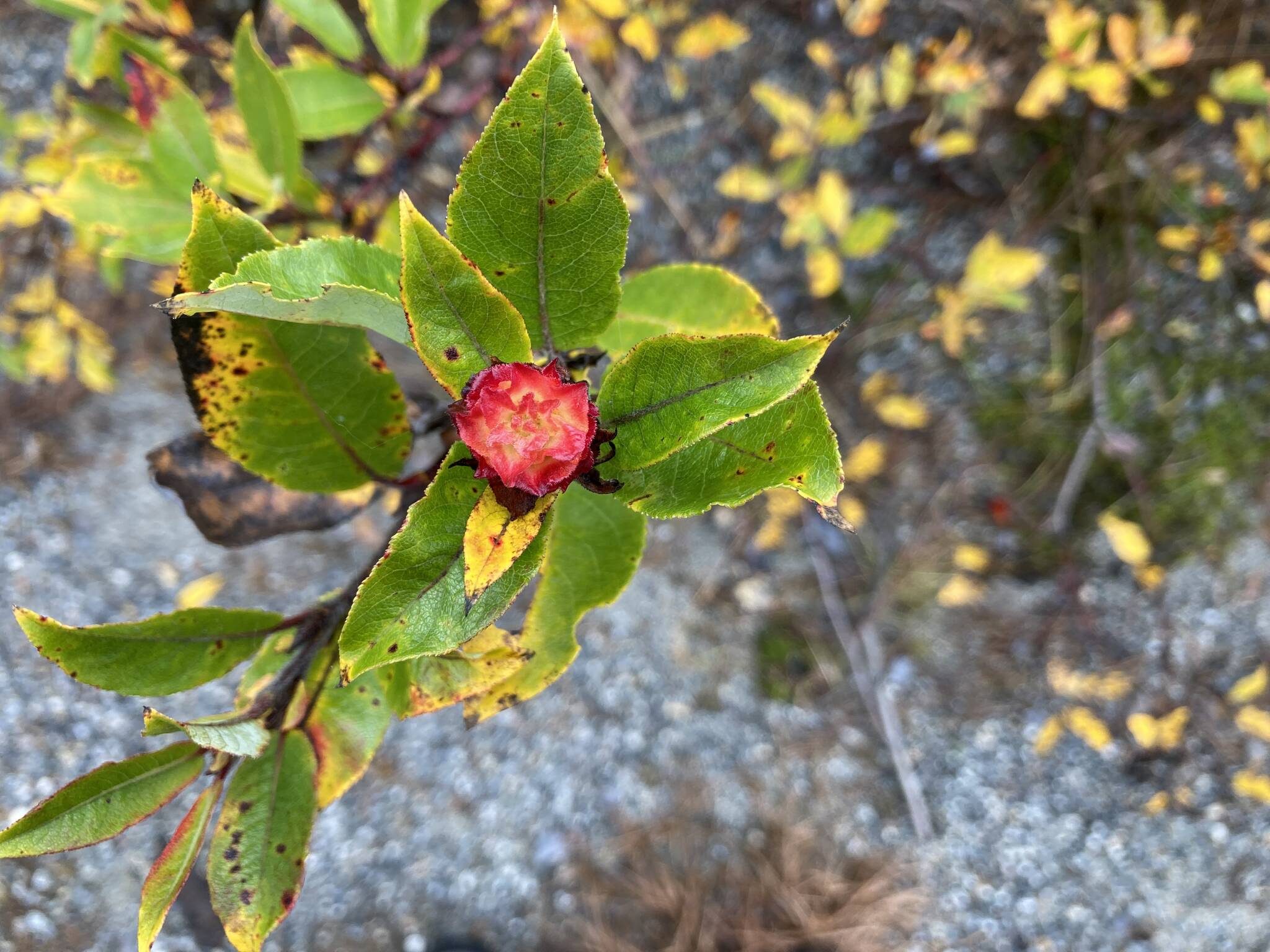It’s been rather quiet along the trails in late September: here a pair of hermit thrushes, there a trio of varied thrushes, and a stray robin or two. Coho were milling about in Mendenhall Lake, rumpling the water surface. From the beach on the west side, I watched a seal or two making bigger rumples as they tried to grab a fish. I saw no coho going up the west-side streams, as they usually do, but they were going up Dredge Creek on the other side of the lake.
I met a dog-walking fellow who remarked on his enjoyment of the fall colors, as we looked at the golden cottonwoods, yellow willow leaves, and the red/pink/yellow leaves of highbush cranberry. Dwarf dogwood has been spectacularly red along some trails, with small spots of color from trailing raspberry and nagoons. Along the lakeshore trail, new willow-roses were developing, showing brilliant red on a background of still-mostly-green willow leaves. The midge larvae inside will emerge next spring, having fed on the inside of the gall, and face the world as adults.
Meanwhile, I was sent a link to an article in a Wisconsin newspaper about huge swarms of dragonflies headed south on their fall migration. Tens and maybe hundreds of thousands of dragonflies were on their way, attracting so much public attention that they even made it into the newspaper (and there are other migrating swarms, on the east coast, near the west coast, and in between). Several species had joined the swarm, but the great majority of them were green darners (Anax junius)—possibly my favorite dragon, very snazzy. The Latin name means June king—“king” perhaps because of its large size, with a wingspan of almost twelve centimeters, bigger than most other North American dragons. They typically breed in quiet waters of vernal pools and marshes, where the females lay their eggs on aquatic plants. These mighty predators are able to capture and eat other adult dragonflies, as well as many other insects. They range over most of North America, coast to coast, from southern Canada to Mexico, Hawaii, and beyond. They don’t get to Alaska except by accident of vagrant winds. But their regular migrations take them from the northern part of the range to the southern part in fall, and back again in spring.
Green darners are well-known for making long-distance migrations and we now know a little more about their fall travels. The advent of miniature radio transmitters, small enough to be glued onto a dragon’s back, allowed researchers to follow their progress for several days. The dragons made an average of about twelve kilometers per day, with stopover days for foraging in between the flight days. They took advantage of northerly winds, after a cool night or two, and typically flew with the wind, although they seldom flew on very windy days.
The swarms are apparently more common in fall than in spring. Swarms are composed of individuals from widespread areas, gathered together in fall to follow shorelines, ridgelines, and other landmarks. Individual dragons bore natural markers in the form of isotopes that could be identified to their approximate sources; natural isotopes of hydrogen, for instance, can have one, two, or three neutrons, changing their atomic mass (‘weight’). The proportion of hydrogen isotopes (in water, for example) varies geographically (e.g., latitudinally), and this is reflected in the body composition of the critters that grew up in different areas.
A simple version of green darner migration divides things into three generations. Generation No.1 emerges in the south in February to May, flies north, where it breeds and dies. Generation No. 2 emerges from that breeding activity in the north, flies south to breed and die. Generation No.3 are the offspring of fall migrants and do not migrate; these residents breed and die in the south and their offspring migrate north in spring.
But it’s not really quite that simple! Individuals in the green darner population of some places (data from two studies in the north) seem to be comprised of individuals with two different migratory patterns. A given population may have some adults emerging and breeding in summer, whose slowly growing larvae overwinter in the breeding pond, emerging the next summer to breed there as adults. Other individuals in the same pond are small larvae in early summer (whose parents were spring migrants); these grow quickly, with adults emerging and breeding in late summer and fall, and then disappearing on fall migration. This makes it seem that these northern populations contain both residents and migrants.
Studies of the population genetics have shown that green darners have not differentiated into distinguishable populations but rather exhibit widespread similarities, which indicates genetic mixing throughout the whole population. Spring migrants probably do not go back to where the previous generation of their parental lineage came from; they may settle to breed somewhere along the way. Their offspring therefore cannot be closely adapted to particular rearing conditions in various geographic areas. So researchers now consider the possibility that the life-history differences (resident vs migrant) may be flexible. Perhaps the early larvae decide which life history to take on the basis of some environmental trigger.
There is much to be learned about migratory strategies in green darners. What cues do the migrants use for orientation on the long flights? How do they decide where to settle and breed? Do the offspring of a given female actually embark on differing life histories, depending on circumstances? If life histories are flexible, what are the triggers that determine which alternative prevails? Will the relative frequencies of the two pathways change as the climate changes?
• Mary F. Willson is a retired professor of ecology. “On the Trails” appears every Wednesday in the Juneau Empire.

